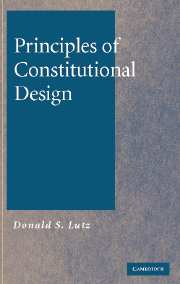Book contents
- Frontmatter
- Contents
- Preface
- Acknowledgments
- Principles of Constitutional Design
- 1 Constitutionalism: An Initial Overview and Introduction
- 2 Sovereignty
- 3 Popular Sovereignty
- 4 The Separation of Powers
- 5 Analyzing the Interaction between Popular Control and the Separation of Powers in the Amendment Process
- 6 Matching a Government to a People
- 7 An Overview of the Constitutional Design Project
- 8 An Underlying Constitutional Logic: Rational Actors?
- Index
4 - The Separation of Powers
Published online by Cambridge University Press: 29 July 2009
- Frontmatter
- Contents
- Preface
- Acknowledgments
- Principles of Constitutional Design
- 1 Constitutionalism: An Initial Overview and Introduction
- 2 Sovereignty
- 3 Popular Sovereignty
- 4 The Separation of Powers
- 5 Analyzing the Interaction between Popular Control and the Separation of Powers in the Amendment Process
- 6 Matching a Government to a People
- 7 An Overview of the Constitutional Design Project
- 8 An Underlying Constitutional Logic: Rational Actors?
- Index
Summary
Why the Term “Separation of Powers” Is Used
“Separation of powers” is usually associated with so-called presidential systems, but all political systems use separated powers to some extent. We later use the concept of a “pure parliamentary system” to explicate precisely the codification of an Index of Separation of Powers and demonstrate that only two or three political systems reasonably approximate a pure parliamentary system. At this point it is useful to consider how framers of parliamentary systems develop ways to limit majority rule and to indicate in preliminary fashion why such limits are best considered as manifestations of a separation of powers.
In a “pure” parliamentary system, an electoral majority is translated into a parliamentary majority, and that parliamentary majority selects a prime minister who serves as the sole executive. Also, parliament is the final court of appeal for judicial matters. As we will see, this model is almost always rejected in practice for a more complex one. For example, almost all parliamentary systems also have a separately elected or appointed executive outside of parliament, as well as a supreme or high court that serves as the final body for legal appeals. Regardless of the actual powers of these two separate entities, they articulate institutionally a reluctance to place the power for all governmental functions in the same hands.
- Type
- Chapter
- Information
- Principles of Constitutional Design , pp. 109 - 144Publisher: Cambridge University PressPrint publication year: 2006



